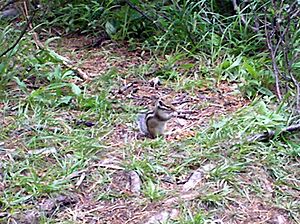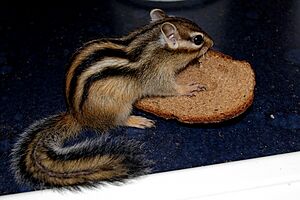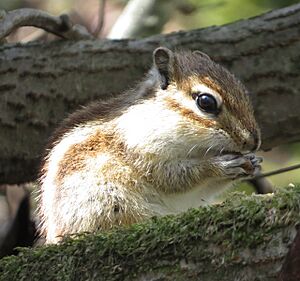Siberian chipmunk facts for kids
Quick facts for kids Siberian chipmunk |
|
|---|---|
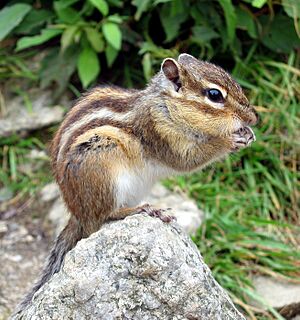 |
|
| On the mountain of Seoraksan, South Korea | |
| Conservation status | |
| Scientific classification | |
| Genus: |
Eutamias
|
| Species: |
sibiricus
|
| Subspecies | |
|
|
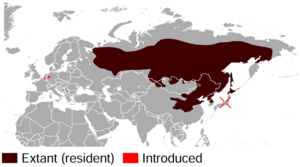 |
|
| Siberian chipmunk range. | |
| Synonyms | |
|
Tamias sibiricus (Laxmann, 1769) |
|
The Siberian chipmunk (Eutamias sibiricus) is also known as the common chipmunk. This small, striped animal originally comes from northern Asia. You can find it in places like central Russia, China, Korea, and Hokkaidō in northern Japan. In the 1960s, many Siberian chipmunks were brought from South Korea to Europe to be kept as pets.
Contents
What Does a Siberian Chipmunk Look Like?
Siberian chipmunks are easy to spot with their unique stripes. They usually have four white stripes and five dark stripes running along their back. These chipmunks are about 18 to 25 centimeters (7 to 10 inches) long. About one-third of their length is their tail.
Their weight changes throughout the year. It depends on how much food they can find. A grown-up chipmunk usually weighs between 50 and 150 grams (1.7 to 5.3 ounces). Male and female chipmunks look very similar. You can only tell younger chipmunks from older ones by their size.
These small animals typically live for two to five years in the wild. However, if they are kept as pets, they can live much longer, sometimes up to ten years!
Where Do Siberian Chipmunks Live?
This chipmunk species is native to many parts of Asia. They live across Russia, from northern Europe into Siberia. You can also find them in eastern Kazakhstan, northern Mongolia, and parts of China. They are common in Korea and on several Japanese islands like Hokkaido.
How Did Chipmunks Get to Europe?
In the 1960s, South Korea started sending these chipmunks to Europe as pets. Between 1960 and 1980, over 200,000 chipmunks were exported to Europe.
By the 1970s, people started seeing them in parks across Europe. Small groups of chipmunks began living in suburban forests and city parks. This happened in countries like Belgium, France, Switzerland, Germany, and the Netherlands. Many owners let their pets go free, or the chipmunks simply escaped.
For example, the chipmunks in the Netherlands escaped from a zoo that closed down. Even though thousands of chipmunks were introduced, they don't spread very quickly. They move only about 200 to 250 meters (650 to 820 feet) per year. This slow movement keeps them from spreading too far from where they were first released.
Are Siberian Chipmunks an Invasive Species?
In Europe, the Siberian chipmunk is now considered an invasive alien species. This means it's on a special list called the "List of Invasive Alien Species of Union Concern" since 2016. Because of this, it's not allowed to import, breed, sell, or release these chipmunks on purpose anywhere in the European Union. This rule helps protect local wildlife.
What is the Siberian Chipmunk's Habitat?
Siberian chipmunks can live in many different places. They often live in coniferous forests, which are forests with trees like pines and firs. They also like rocky areas within forests and mountains. You might find them in bushy areas, near rivers, or along roads. Sometimes, they even live near small farms.
In Europe, the chipmunks that were introduced usually live in deciduous forests (trees that lose their leaves) or mixed forests. They also live in city areas with lots of green spaces. These chipmunks can survive in very different temperatures, from very cold (−65 °C or −85 °F) to quite warm (30 °C or 86 °F).
Chipmunks don't travel far on their own. They also have trouble crossing big obstacles like roads or swamps. This means they usually stay close to where they were born or released.
Chipmunk Territories
Siberian chipmunks live in groups, but each chipmunk has its own space, called a territory. This territory can be quite large, from 700 to 4000 square meters (7,500 to 43,000 square feet). Female chipmunks usually have larger territories than males. Their territories are also bigger in the fall than in the spring.
Chipmunks mark their territory using their urine and special glands in their cheeks. This is one way they communicate with each other.
Siberian Chipmunk Behavior
Siberian chipmunks usually live alone. But in winter, they often share a burrow with another chipmunk. Their burrows can be up to 2.5 meters (8 feet) long and 1.5 meters (5 feet) deep. Inside, they have a nest chamber, several rooms for storing food, and even places for waste.
During winter, these chipmunks store about 3 to 4 kilograms (6.6 to 8.8 pounds) of food. This food helps them survive underground until spring. Besides sharing burrows, they also use different sounds to talk to each other. They make a quick, sharp sound when they are scared. They also make a deep croaking sound, which is thought to be used for mating.
Reproduction and Life Cycle
Siberian chipmunks usually breed once or twice a year. This happens after they wake up from hibernation, around mid-April. A mother chipmunk can have between three and eight babies at a time.
When they are born, the babies are blind and have no fur. They weigh only about 3 to 5 grams (0.1 to 0.2 ounces). After about 28 to 35 days, their eyes open. The mother takes care of her young. She teaches them how to find food when they are about six weeks old. The babies stop drinking milk around seven weeks. They become independent around eight weeks old. By three to four months, they reach their adult size. Both males and females can have their own babies when they are about nine months old.
What Do Siberian Chipmunks Eat?
Siberian chipmunks are omnivores, meaning they eat both plants and animals. They often collect and store food. Their favorite foods include pine seeds and seeds from other trees. They also eat plant roots, insects, molluscs (like snails), birds, reptiles, grains, fruits, and fungus.
Siberian Chipmunk in Nature
Siberian chipmunks are an important food source for other animals. Birds of prey, such as hawks and owls, hunt them. Weasels and small cats also prey on chipmunks. Chipmunks stay safe by being alert, hiding in their burrows, and using their fur to blend in with their surroundings.
These chipmunks help nature in several ways. They spread seeds and fungal spores as they move around. Other animals sometimes eat the food they have stored. They may also help control pests that harm forest trees. In Russia, chipmunks eat about half of the forest nuts. In Belgium, some people believe chipmunks eat the eggs or young of birds that nest on the ground.
If Siberian chipmunks were introduced to Britain, they might compete with other small animals for food. These could include the red squirrel, wood mouse, and bank vole.
Siberian Chipmunks and People
Some people keep Siberian chipmunks as pets. Others sell them for their fur or other body parts. Chipmunks can sometimes eat crops and damage gardens. In Russia, they can cause problems for grain fields and fruit orchards.
Siberian chipmunks can carry Lyme disease. This disease is caused by bacteria and can be spread to humans through ticks. In a study near Paris, chipmunks were found to carry more of the disease-causing bacteria than local animals. This means they might contribute to more infected ticks, which could increase the risk for humans.
Images for kids




